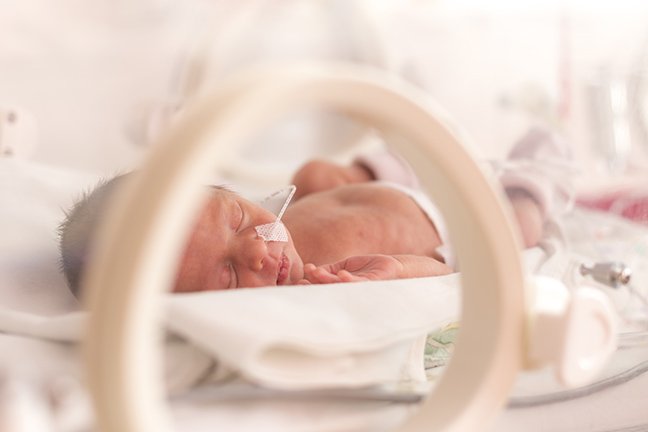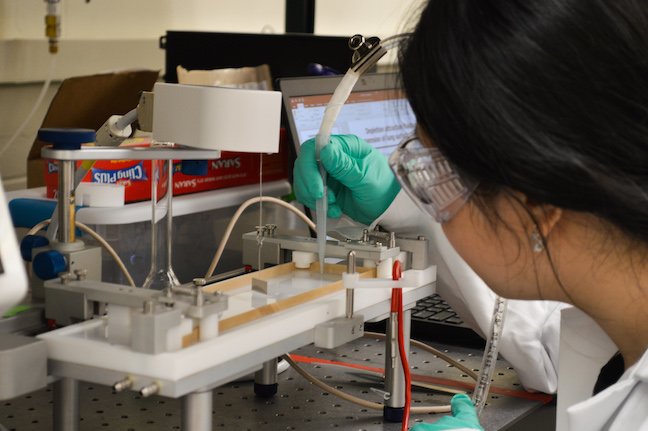Clara Ciutara's research is a breath of fresh air

Above: Ciutara is part of a research team developing a synthetic substance that would coat the lungs, helping infants and adults with Respiratory Distress Syndrome (RDS) breathe more easily. Credit: iStock
CSE grad student aims to help infants and adults inhale and exhale more easily
June 14, 2019
Clara Ciutara always thought she wanted to go to grad school for something electronics-related. But when the Indonesia native, who holds a bachelor’s degree in chemical and biomolecular engineering from the Korea Advanced Institute of Science and Technology, came to the University of Minnesota, that all changed.
“I knew I wanted to immerse myself deeper in materials science instead of sticking to the traditional chemical engineering field because I’m very interested in the material side of chemistry,” she said. “I like it [at the University of Minnesota] because it’s very collaborative within the department.”
Now, as a third-year graduate student studying materials science in the Department of Chemical Engineering and Materials Science (CEMS), Ciutara is part of a research team developing a synthetic substance that would coat the lungs, helping infants and adults with Respiratory Distress Syndrome (RDS) breathe more easily.
Human lungs naturally produce this “surfactant,” or surface-active agent, to keep the airways open and thereby make breathing easier. However, patients with RDS don’t produce enough of the substance, causing airways to gradually collapse. Neonatal RDS is the leading cause of death in premature babies, and the adult version, Acute RDS, has a 40 percent mortality rate.
A life-saving job
While treatment is available through animal surfactants, Ciutara said this process is very expensive, does not always work, and raises contamination concerns. As part of University of Minnesota CEMS professor Joe Zasadzinski’s research group, Ciutara’s team is trying to find the right combination of lipids, proteins, and other molecules to produce a suitable synthetic lung coating.
Ciutara has been working on the lung surfactant project for over a year. A big part of her contribution lies in rheology, measuring the flow of materials to find the best way to deliver the surfactant into human lungs.
“What really got me interested [in this project] was the big implication: saving babies!” Ciutara said.
“It’s also interesting to study the fundamental science and see how far we can extend it to other systems," she said.
In addition to saving lives—both infant and adult—Ciutara said the research has jumpstarted her interest in the biomedical and pharmaceutical industries as well as given her valuable experience in the field of rheology.
“These days people are very interested in studying the interfacial behavior of antibodies and other proteins in the body,” she said. “This kind of skill set I’m getting by studying the rheology and interfacial behavior is especially useful for therapeutics purposes.”

Choice made easier
A recipient of the CEMS First-Year Graduate Student Fellowship—plus the Department of Chemical Engineering and Material Science’s Nancy Scott and Kevin Gromley and Robert V. Mattern Fellowships—Ciutara said the financial support was one of the main reasons she chose the University of Minnesota.
She said it would have been harder to afford grad school without them. As an international student, Ciutara said it is more difficult to apply for loans when you aren’t a United States citizen.
The College of Science and Engineering boasts the largest number of graduate students at the U of M—907 master’s students and 1,710 doctoral students—with 59 percent being international students and students of color.
“My fellowships really help me focus on my studies and everything else, especially giving me enough time and flexibility to explore various research areas,” Ciutara said. “I came here knowing nothing about all of the things I know now. I’ve learned a lot, and the more I learn I’ve only become more interested in science and its impact on our everyday lives.”
Story by Olivia Hultgren
If you’d like to support students in the University of Minnesota College of Science and Engineering, visit our CSE Giving website.
